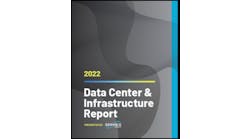Key Observability Considerations to Support Digital Infrastructure
We continue our article series on designing data centers for observability, resiliency, and better operations. Last week, we’ll explored the journey from legacy to modern data center infrastructure. This week, we’ll examine how observability has changed to support digital infrastructure.
Get the full report
Organizations that treat data centers as a direct part of their business will leverage technology as a competitive advantage. How well is it all being managed as the data center footprint expands? What is the organization doing to create granular visibility into the entire portfolio of connected systems?
Data centers are purpose-built facilities with lots of complex technology. Managing those technologies has been problematic. At best, devices have management software, but individual software systems do not work together. At worst, blinking lights needed to be monitored in person.
The result is a highly tuned system that, when it breaks, can take down an entire business. Emerging solutions around data center management are changing this. It’s key to see everything within the environment and incorporate intelligent monitoring to support critical architecture.
When it comes to data center management in a digital era, consider the following four points:
- Everything is connected. Critical infrastructure must work as a system. Devices such as power and cooling delivery need to be connected to a common network to allow seamless monitoring.
- Working with sense and respond software is important. Management software needs to do more than just describe what happened. It needs to provide trend analysis and intelligence to identify problems before they happen and solve them.
- Innovation through integration. Look for in-house software development resources to integrate disparate software management tools into
a robust system. - Secure portals and reporting help simplify operations. Gain an online view of the critical infrastructure and the ability to produce reports and trending.
When data center leaders grasp the monitoring and data center management side of things, it is easier to incorporate policies, compliance, and controls over the metrics. After all, what good is an alert if it’s unknown what to do next?
To get to a better operational state, it’s essential to begin by asking the right questions.
Asking the Right Questions, Overcoming Digital Dilemmas
There is a fundamental shift in working with and looking at digital infrastructure portfolios, and this is why the way partners are sourced and engaged must also change. In many cases, it’s key to ensure that the partner can support people, processes and technology. Furthermore, it’s critical to challenge partners on their supply chain strategies and that their overall business strategy aligns with the business. Some things to consider:
- Does the supply chain have strategic importance to the partner? Can they demonstrate how they align business and strategy with supply chain management?
- Where are the risks? Can the partners showcase their capabilities and support their supply chain for optimal performance?
- Can the partner’s solutions help the business scale? Will a supply chain snag create additional headaches for the business?
- Is there change management processes that are built-in and that continually review key supply chain elements? Do they also look for opportunities to improve quality and operational efficiency?
- Does the supply chain minimize the number of touches and the touch time in supply chain transactions to reduce the number of potential points of failure?
- Can the partner effectively support people and their initiatives? Can it give leaders the right level of observability into the supply chain, business and overall operations?
- Can the partner think globally and execute locally?
As many leaders want to improve operations, become better with sustainability and help their staff become less tired, some emerging considerations face digital infrastructure. These issues include:
- Distributed infrastructure has created new questions around management. The way we connect and leverage resources are far different than even just a few years ago. Today, more extensive infrastructure portfolios are helping organizations stay ahead of a diverse and digital market. This translates to strained visibility levels where edge ecosystems and smaller locations may not have the observability required to scale the business.
- Unclear root causes can take a long time to resolve. Taking too long to find out the root cause of an issue can waste time and resources. Fixing a critical issue is essential; it is even more important to make sure that it doesn’t happen again.
- Admin fatigue is a real issue in the connected age. Data centers technicians and IT administrators are tasked with maintaining critical infrastructure. When too many dashboards, alerts, and sensors go off, creating the ‘swivel chair’ analysis issue is possible. This means administrators might miss key issues or not even know which screen to look at. Without good observability, the human element quickly becomes stressed and fatigued.
- Lack of standardization will impact compliance, regulation and even safety. Disparate systems, too many non-integrated components, and silo operations lead to a lack of standardization. This also creates problems with compliance and regulation. Another major issue with a lack of standardization is observability across the entire portfolio. As our environments grow, they become more complex, and working with standardization and visibility tools makes managing those ecosystems easier.
- Challenges with scale will impact how the business can grow. Without good visibility, it can be difficult to scale a business effectively. The ability to scale at the pace of a digital market and business-specific requirements means having visibility into the entire ecosystem.
- Loss of productivity and efficiency. The human element is critical to success, and they need proper tools to improve effectiveness and productivity.
- Sustainability issues will lead to future ESG issues. It is difficult to effectively deliver on ESG goals without observability across the entire data center and infrastructure portfolio.
We’ve discussed how data center operations have changed, where new sustainability metrics impact digital infrastructure and some of the emerging issues facing operations. To overcome these issues, leaders must look beyond traditional means of data center management. To get ahead in a digital space, observability must handle the digital infrastructure in a holistic fashion. Let’s dive into what that means.
Observability That’s Designed for Digital Infrastructure
The graphic below illustrates the elements of a digital infrastructure that require strong observability.
Source: Honeywell
It’s important to show how modern digital infrastructure portfolio visibility tools can impact an organization.
- Look for building and infrastructure managing systems solutions that provide portfolio visibility. New solutions can manage the data center’s building, power and systems via and open platform to deliver uptime and operational efficiency. Digital infra- structure is a ‘living’ entity that’s constantly evolving.
- Use a solution that supports overall ESG goals. Consideration needs to be made for energy optimization, water conservation and overall energy management.
- Consider controls that can support various systems. Deploy a solution that provides total observability into the entire portfolio of solutions, including IT, OT, DDC and even PLC controllers to deliver more reliable uptime.
- Work with solutions that deliver smart, predictive and prescriptive critical infrastructure management. These designs will deliver more sustainability, efficiency and uptime by intelligently managing critical resources, like power, grids and microgrid solutions.
- Deliver higher-value services with better visibility. Work with data-driven, machine-learning solutions that actively analyze data patterns
to help with operational efficiency, thermal optimization, and more. Higher-value services and systems work with data and cross-domain integration and optimization to deliver the next generation of data center management. - Leverage designs that support intelligent command systems to address security concerns. Security is always a concern so systems that offer improved access controls, n integration and asset protection through next-generation threat identification and response management.
When organizations use an open, end-to-end platform can enhance operational processes. Some positive outcomes include:
Data center leaders can experience a 10% energy reduction with better visibility and controls. Leveraging technology that works with data-driven and machine learning tools, leaders can use data to see previously inaccessible patterns.
With portfolio-level visibility, data center professionals can see a 10-20% cost reduction in maintenance. Managing a portfolio view also means greater data management, increasing visibility while limiting the volume of information allowing data center managers to understand their ecosystem better. This translates to better insights, improved observability and reduced maintenance.
Download the entire paper, “The Data Center Human Element: Designing for observability, resiliency and better operations,” courtesy of Honeywell, to learn more. In the next article, we’ll discuss one more important point when creating observability in digital infrastructure: The people. Catch up on the previous articles here and here.






